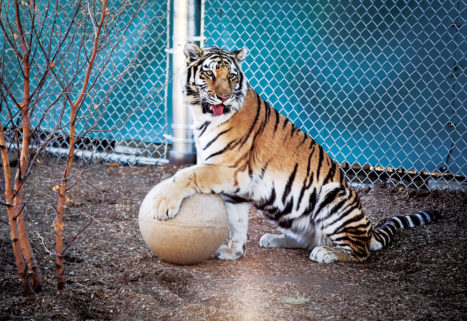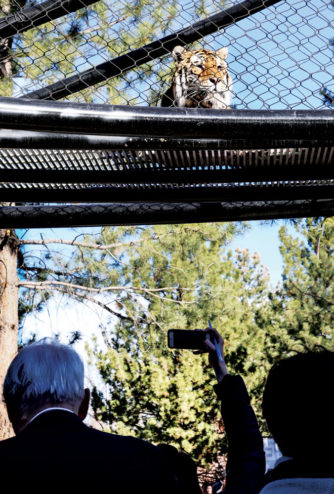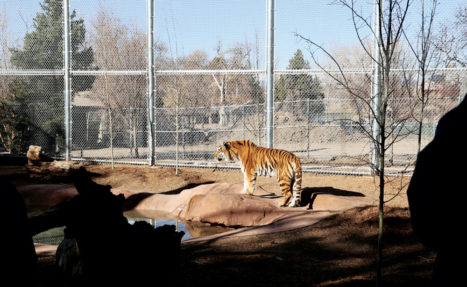
The question, “Are you being watched?” looms over the heads of visitors at the zoo’s new tiger exhibit, The Edge, as the tigers look down on them.
One of the most striking features of Denver Zoo’s newly opened tiger exhibit, The Edge, is the metal mesh catwalk that arches above the visitor viewing area. The big cats peer down as guests look up at them, creating the interactive experience that its designers intended.

The Edge offers the tigers, like male Nikolai, a highly enriched and stimulating environment while promoting an engaging and interactive experience for zoo guests (right).
At the opening for media and zoo supporters in early March, the contact was particularly close: the large male tiger, Nikolai, shook his damp coat and sprayed attendees below with a liquid of unclear origin. Happy Haynes, director of Parks and Recreation for the City of Denver, playfully referred to it as a “christening,” apropos of the occasion.
The name of the new tiger exhibit, The Edge, reflects several aspects of the project: a close relationship between guest and tiger occurs in the space; the yard is designed to appear as if on the edge of a forest; and it reminds visitors that the Amur tiger species, the largest living member of the cat family, is on the brink of extinction, says Shannon Block, president and CEO of Denver Zoo.

Visitors to The Edge at the Denver Zoo.
The Edge has two separate outdoor enclosures, allowing two of the otherwise solitary Amur tigers to observe and be observed while exploring their new and enriched environment. At the opening, Nikolai and Nikita were outdoors while the zoo’s third tiger, Thimbu, Nikolai’s brother, was exploring the 3,000-plus sq. ft. indoor space. The tigers rotate regularly through the indoor and outdoor exhibit areas, depending on keepers’ schedules and the cats’ motivation, according to Sean Andersen-Vie, public relations manager.
The tigers, born and bred in zoos, seemed at ease in their new digs, unfazed by the throng of eager visitors. As Nikolai strutted above the crowd and frolicked in his play pool, amber eyes flashing, Nikita kept her distance, calmly watching the assembled spectators while basking in the late winter sun.
Zookeepers hope that Nikita, who is related to Nikolai and Thimbu, will be bred with a third male tiger that will soon arrive from Russia. Trainer Kim Pike says Amur tiger gestation is approximately 103 days—about 3½ months—and females are generally in estrus year-round. With some luck, it seems likely that the zoo will welcome tiger cubs before too long.
Exhibit Design
As regular visitors to Denver Zoo can attest, the tigers have long appeared to be in need of a new habitat. “We felt very passionate about it as well,” said George R. Pond, senior vice-president/vice-president for design and campus management. “It rose to the top of a very long list of priorities” that the zoo developed after the passage of the city’s 2007 Better Denver Bond, which provided $2.2 million in funding for the zoo.

A Tiger enjoys his new environment at the Denver Zoo.
Nearly twice the size of the previous tiger space, The Edge was largely built and designed in-house by zoo staff in conjunction with CLR Design, a process that took nine months of planning and 19 months of execution. One of the design priorities was “creating great habitat for the tigers, opportunities for them to be in different positions, high and low, water features,” said Pond, while simultaneously “putting people in a new relationship” with the animals.
To that end, most of the outdoor enclosure is made of woven metal mesh, allowing for sights, sounds and smells to pass freely. Zoo staff designed a unique perforated wall that allows visitors and tigers to come within six or eight inches of one another, noted Pond. It is possible to hear the “chuffs” of the tiger and even smell its breath from that distance.
The Edge of Extinction
Once inhabiting much of Siberia, fewer than 400 of the species, formerly known as Siberian tigers, are now alive in one small area of eastern Asia along the Amur River. Poaching and habitat loss through logging have contributed to the species’ decline, and Amur tigers are currently classified as endangered.
Block suggests several ways to help the tigers, including supporting Denver Zoo and its anti-poaching efforts, buying sustainably and responsibly sourced wood, and purchasing tiger ear headbands, which help sponsor the Amur tigers at the zoo.



Wow… this looks great. Will definitely visit when next I’m in Denver. Anyone have descriptions of how to get there?
If you google “Denver Zoo” you can find all the information you will need. You can also visit http://www.DenverZoo.org.